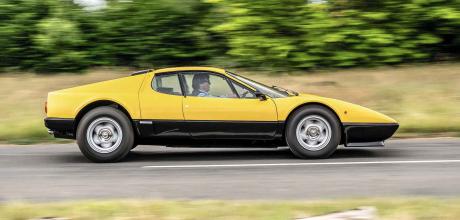1977 Ferrari 512BB
This very Ferrari 512BB appeared on a poster to advertise its 188mph top speed. Can it still promise such thrills today? Robert Coucher drives the star of many a bedroom wall.
Photography Barry Hayden
‘I liked the poster so much. I bought the car.’
Poster car that advertised its 188mph top speed — and the owner who idolized it from childhood.
Driving the actual 188mph supercar immortalized in one of the 1970s most famous car posters
Remember the days before smartphones and social media? The days when people read magazines and tore out pictures they liked or unpicked a centre-spread poster to stick on their walls? Athena prints and other posters were all the rage, with Farrah Fawcett the best-seller in 1976, followed closely by the famous ‘tennis girl’. You know the one.
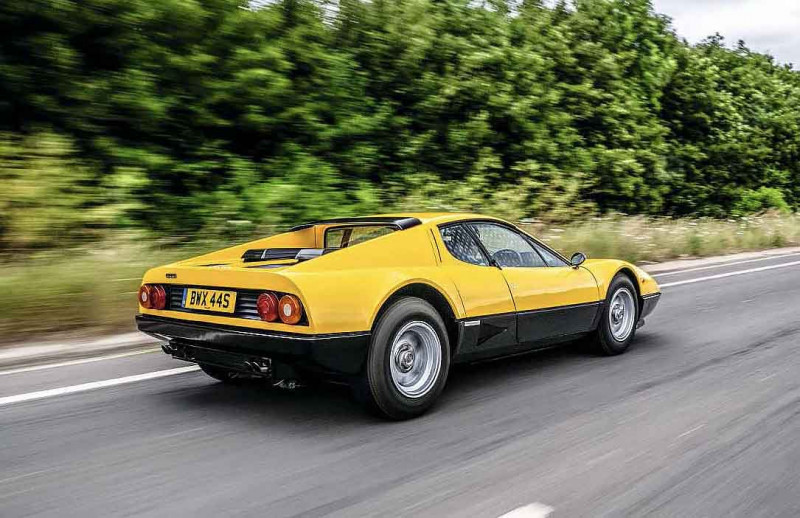
As for young car types, the way we expressed our enthusiasm for a particular marque was by having a car poster on the bedroom wall. It seems impossibly simple and old-fashioned these days, as seemingly everyone has thousands of clips on their phones with fast cars indulging in all sorts of silly antics, often ending in a crash.
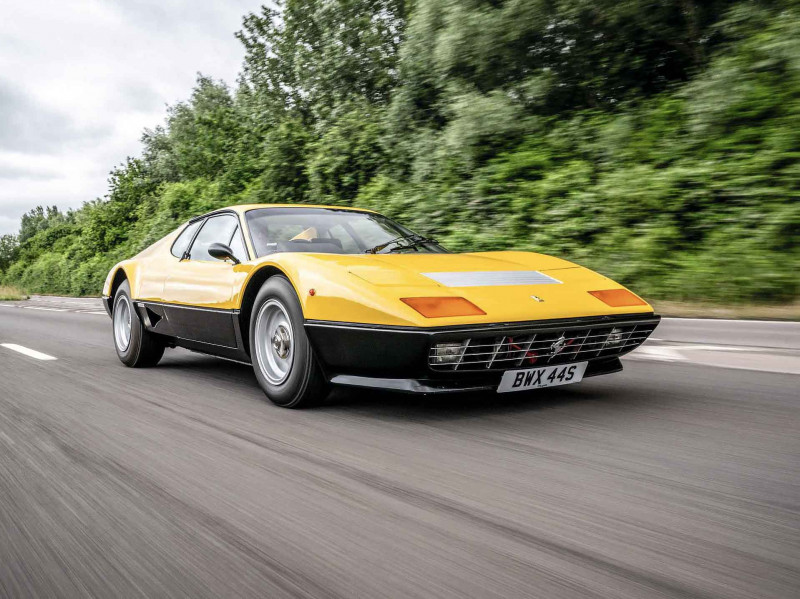
But back then, ‘poster cars’ were an important barometer of what was cool and desirable in the world of motoring. Needless to say, only supercars were accorded the bedroom-wall honour; they included Aston Martin, Jaguar, Maserati, Porsche and, of course, Ferrari. Actually, this very Ferrari, making it one of the most famous 512BBs of the lot.
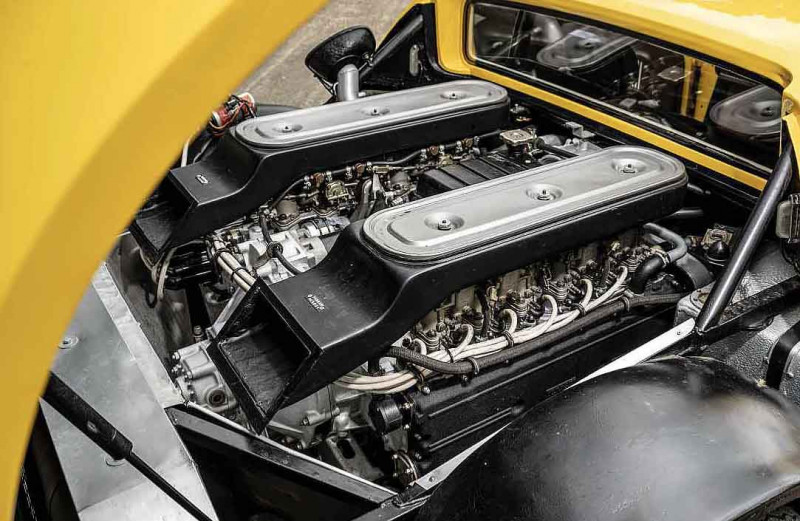
Chassis number 21689, one of only 927 BBs produced, is a rare right-hand-drive example purchased new in 1977 by the well-known racing driver Chris Meek, who owned Mallory Park circuit. At the time, Ferrari was claiming that its new supercar, the considerably updated 512BB that followed the original 365 GT/4 BB, had a top speed in the region of 188mph. Unfortunately, when road-tested in the US, Europe and Britain, the 512BB was unable to reach that magical figure, with Autocar managing only 163mph in its 6 May 1978 issue. Not bad, but not supercar enough for one owner, who decided to go legal with Colonel Ronnie Hoare of Maranello Concessionaires, claiming he’d been deceived.
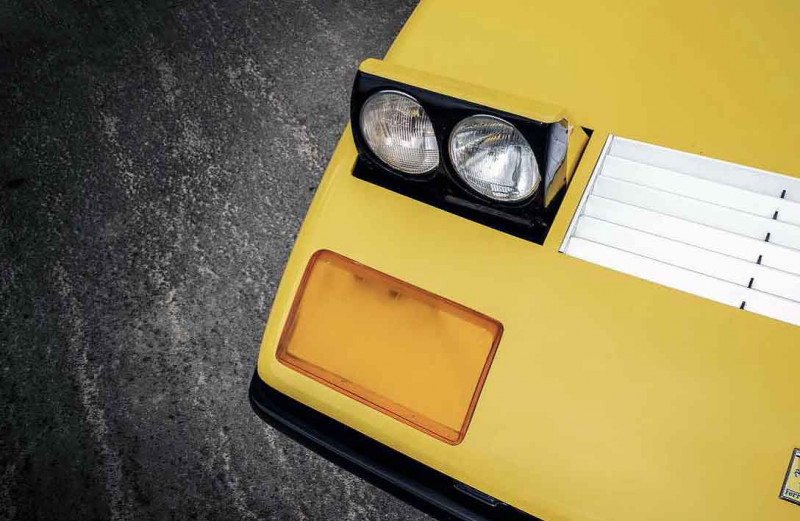
So racer Meek thought he’d do a test run to find out exactly how fast the 512BB actually was in the real world. Which is how he, a crew of mechanics from Huddersfield Garage, men from Michelin and a nervous envoy from Ferrari in Maranello came to be gathered on a deserted M1 at five in the morning.
With photographer Mike Hargreaves strapped into the passenger seat, Meek wound up the BB to an indicated 188mph and Hargreaves took the shot, immortalizing this Ferrari as a poster car as well as a supercar. The Colonel then showed the litigious customer the photo and that was the end of it A while later Meek received a call from Ferrari, asking him to visit the factory. When shown into Enzo Ferraris office, Meek was pleased to see the poster on the wall and Enzo thanked him for proving the 512BB could reach the figure the factory had claimed, making it apparently’ the fastest car in the world.
What wasn’t mentioned is that the heroic figure of 188mph was merely an ‘indicated’ speed on the electronic speedometer, an instrument not renowned for its accuracy, especially towards the top of the dial. But hey, Enzo never let the facts get in the way of a good story and II Commendatore was happy he now had the fastest car in the world once again, along with a poster to prove it!
Enzo Ferrari didn’t take this matter lightly because his domination of the very fast road car market had been badly dented with the arrival of the Lamborghini Miura in 1965, which had been lauded as the world’s first supercar. Ferrari thought that road cars should have their engines mounted up front and this conservative philosophy continued with the 365 GTB/4 Daytona in 1968. Lamborghini promptly turned around and launched the outlandish Countach LP400 in 1974 — probably the most iconic poster car of all.
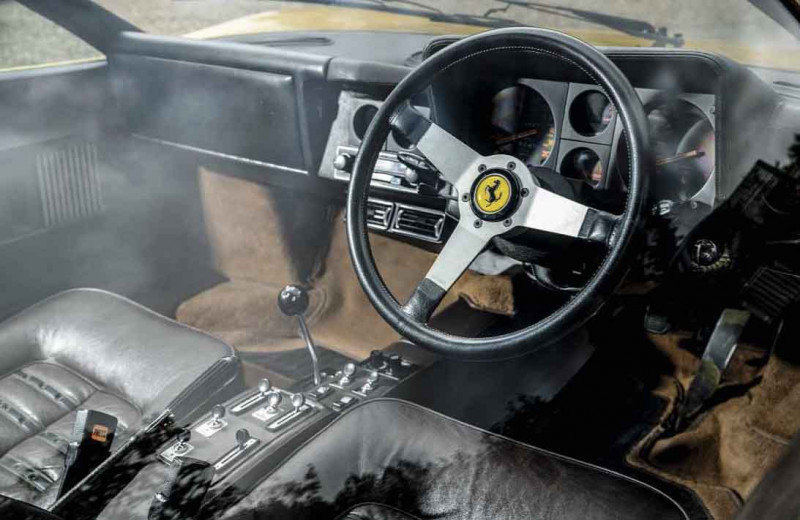
The writing (well, the picture) was on the wall, so Ferrari had to react. Drawing on its mid-engine racing car expertise garnered with the successful 250LM and Dino 206, lead engineer Angelo Bellei developed a semi- monocoque steel chassis with unstressed front and rear bodywork. Suspension was raceproven wishbones all round, all four wheels slowed by disc brakes. The exciting new engine was not a traditional V12, instead being a development of Mauro Forghieri’s flat-12 used in the Ferrari 312B Formula 1 car.
‘Fat rear haunches wrap around the mid-mounted flat-12, indicating serious power’
The car’s striking looks were the work of Leonardo Fioravanti at Pininfarina, realized structurally in steel with aluminum doors and front and rear clamshells plus glassfibre lower valances and bumpers. This advanced- spec Ferrari 365 GT/4 BB was presented to the motoring world at the Turin motor show in 1971 before being launched in 1973. Although BB stands for ‘Berlinetta Boxer’, the engine’s firing order means it’s better described as a 180" V12 than the flat-12 ‘boxer’ its name suggests.
That 4.4-litre 12-cylinder engine was capable of 365bhp, and the Ferrari was timed by Road & Track magazine as hitting 60mph from rest in 6.1 seconds and reaching a top speed of 175mph — right up there with the preceding Daytona and the fastest road car of the day.
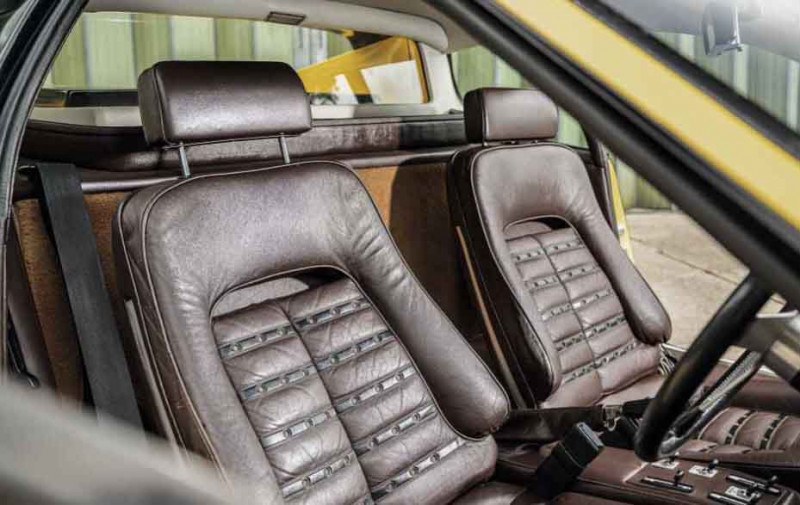
Not that the BB or the Countach were ever planned to be sold in the USA, because of all its emission and safety regulations, but a number of grey-market cars were enjoyed by our American cousins. And, ironically, as the BB was never officially raced by Scuderia Ferrari, it was Luigi Chinetti’s North American Racing Team that campaigned two 365s in sports car racing. The cars were stripped, lightened, fitted with roll-cages and bigger tyres and the team entered the 1975 24 Hours of Daytona. They retired, then finished sixth at the 12 Hours of Sebring. In 1977 the team entered the 24 Hours of Le Mans, finishing 16th overall, and they repeated that result in '78. Ferrari then developed the later and rather ugly 512LM with a best result of sixth overall and first in class at Le Mans in 1981. Not bad for a road car.
At the 1976 Paris motor show, Ferrari replaced the clumsy-sounding 365 GT/4 Berlinetta Boxer with a subtly uprated version marked by a more digestible nomenclature: ‘512BB’. That’s the car you see here. Ferrari had abandoned its long-standing practice of denoting the model by the capacity of an individual cylinder, so the 512 denotes 5.0 litres and 12 cylinders. The most important upgrade was the enlarged engine, bored and stroked to 4943cc with an increased compression ratio of 9.2:1, dry-sump lubrication and a lighter, dual-plate clutch.
'Finished in Giallo Fly with very ’70s brown leather trim, the Ferrari looks sharp, fit and fast’
Peak horsepower was down marginally from the 365BB s 365bhp to 360bhp, but reached at lower revs with the useful addition of more torque, promising a smoother and more user- friendly power delivery. This was to be harnessed by much wider 9in Cromodora alloys fitted to the rear, with the fronts remaining at 7.8in. Visual differences included the addition of a chin spoiler on the front of the 512BB to reduce lift and NACA ducts behind each door to provide cooling for the exhaust and rear brakes. Rear lights were simplified from three to two per side, as with the exhaust pipes, which is a bit of a loss.
ARCH CLASSIC CAR enthusiast and collector Neil Clifford is the boss of the internationally successful Kurt Geiger footwear business, and bought this 512BB about eight years ago. ‘Like most young blokes I had posters of my dream cars on my bedroom wall. My dream came true when I was in a position to afford this poster car, the Ferrari 512BB. This, chassis number 21689, is the very car featured on the poster and was impossible to resist. It’s low-mileage with a great history and I love the colour combination. I don’t really care whether it will do 188mph — but I really like the way it drives.’ He smiles, before adding, generously: ‘There you go… take it for a blast and see what you think.’
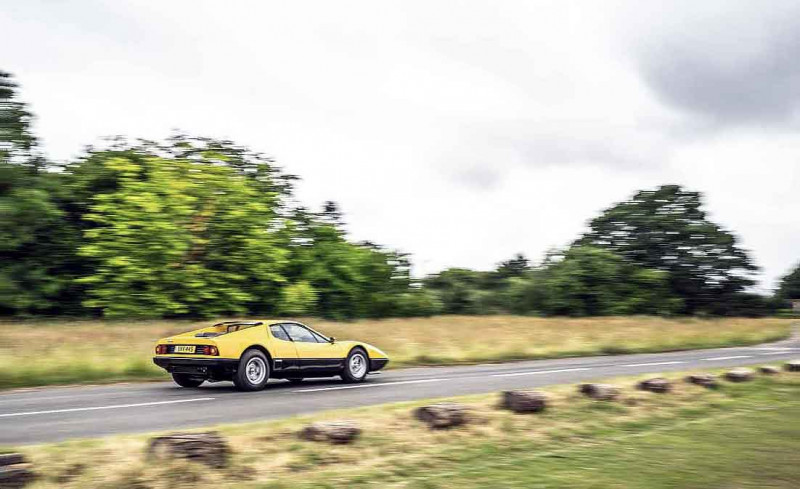
Finished in Giallo Fly with very ’70s brown leather trim, the Ferrari looks sharp, fit and fast.
Modern Ferraris have become rather bloated, like so many of their contemporaries, but every Pininfarina line on this car looks crisp and lean. The long nose and forward-positioned cockpit spell speed, while the fat rear haunches wrap voluptuously around the mid-mounted 12-cylinder engine, indicating serious power.
The classic Ferrari alloys, round tail-lights and signature front indicator lenses lend the 512BB real road presence, so why is it that many of us have not coveted one in the way of some of Maranello’s other models? The whole fashion thing comes back to mind, but today that is no longer of consequence because this Ferrari looks so right. Bigger and more commanding than the smaller Dino and 308, this is a proper man-sized 5.0-litre car with an Fl race-derived engine offering 360bhp. And it’s available at less than a third of the price of the fractious Miura.
You climb down into the low-slung cockpit (the BB is only 44in high) where headroom is spare and the seating position is almost fullrecline. The squidgybrown seats are comfortable and of a good size, adjustable, and designed for normal human anatomy — unlike a Miuras. The door feels surprisingly light when you shut it and, once ensconced, you see the cockpit is airy with good visibility thanks to slim A-pillars and well-positioned rear quarter-windows. The ideally sized steering wheel is deliciously simple, unsullied by switches and ugly airbag protuberances. And there in front of you are the famous red-illuminated instruments, the very speedo that starred in the great poster shot while indicating 188 mph! Don’t think we will be going quite that far round the clock today...
Give the throttle pedal a few judicious prods to prime the Webers and fire up the engine, which catches quickly and settles to a smooth and controlled 800rpm idle. That classically turned alloy gear-shifter with its exposed gate is your driving companion, and it’s a relief to see air-conditioning vents attached to the dash below the original radio. The clutch requires a reasonable shove (this dual-plate one is an improvement over the previous 365BB’s) and cold gearbox oil means the shift is recalcitrant and sticky. So, slide it back into second and the BB moves off without fuss on a big, fat slug of torque. Even within the first few yards you cannot fail to notice that everything about this car is sharp. It has that Ferrari mechanical tingle that you can feel through the chassis and no control has any slop whatsoever.
With the Ferrari warm, it’s out onto some fast A-roads and time to slip the leash. Dip the stiff throttle pedal and the big flat-twelve takes a deep breath, but it does so with turbine smoothness. Prod the gas a bit further, allow the revs to rise around the counter, the engine note hardens and the chassis starts to do its work, laying those 360 horses onto the tarmac with controlled intent.
Soon it’s time for a naughty squirt. Drop the gearlever back a ratio with a metallic clack in that exposed gate — what the hell, thwack it down another gear — grab the steering wheel firmly and mash the throttle. You are instantly reminded that 5.0 litres and 12 cylinders can wake up and get angry. The Ferrari’s growl snaps into the bark of a kicked dog, deepens in tone then goes for the full-yowl crescendo. Whatever you might think of Ferrari as a marque, you just have to feel the intoxicating mechanical exuberance of one of its engines to know that these are very special cars.
It’s at this point you feel the purity of this thoroughbred come through. Today, we are conditioned (and legislated) into driving fast sports cars that are saddled with small engines attached to massive turbochargers and complex management systems. Sure, they move along very quickly indeed, but the driving experience is not, how can I put it, ‘traditional’. This old- school Ferrari engine is a whole different thing. It is much more mechanical and explosive in nature when compared to the computer- controlled units of today.
Sure, 360bhp is no big deal in a world where saloon cars muster well over 500bhp, but it’s the delivery and the whole package that make driving the 512BB such a rewarding experience. You can just tell this car was not assembled by a robot. It has carburetors, for goodness’ sake! And they work beautifully. You can feel them operating with the ball of your foot because there is no fly-by-wire here. The unassisted steering is the same, and brake modulation is controlled by your brain.
I have a couple of cars that will do over 190mph,’ says owner Clifford, ‘but that’s not really the point with this classic Ferrari. I drive the 512 as regularly as I can because it’s just so rewarding. It is a thing of pure mechanical beauty. It’s well-made and still fast in the modern world, and it’s the Ferrari I always wanted.’
The 512 is a quick car and it spears into comers — you can place it with absolute accuracy thanks to the superlative steering. The set-up is inclined towards initial understeer but it answers extremely quickly to throttle inputs so that does not matter. It seems to pivot from the hips as it turns in with alacrity. Gaining confidence, you start to attack bends with more commitment and allow the pliant, high-walled 215/70/15 Michelins at the front and 225s at the rear to define their envelope of grip.
When new, the BB’s engine, mid-mounted high in the chassis over the gearbox, was criticized for causing a noticeable moment of inertia in extremis. In the real world, driven and enjoyed as a classic car, even a classic Ferrari, this is not an issue. Here, you swing the BB into a tight corner, squeal in fulsome power a bit too early and enjoy the sensation of it squatting, with the rear end breaking grip for a little oversteer play. Wonderfully tactile stuff.
So, Neil Clifford has the car as well as the poster. It could sit quietly in his man cave under the famous image and that would be that. But Clifford is a driver and uses all his cars regularly. I’m sure he glances at the poster when he fires up his 12-cylinder, 5.0-litre BB and wonders: ‘Will I kiss 188 today?
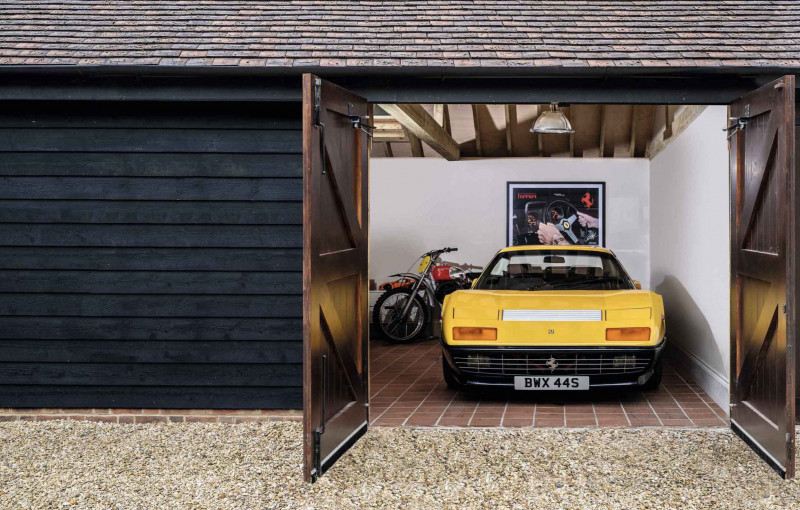
Above Mid-engined BB was Ferrari's riposte to two generations of similarly engineered Lamborghinis, marking a step-change after the classically configured Daytona.
Clockwise, from above left That poster, in which owner Chris Meek coaxed this very car to an indicated 188mph; Fioravanti-designed body is distinctive; race-bred flat-12.
Clockwise, from above Pop-up headlights and large indicator lenses give the BB a face; interior is simple and classic; glorious 1970s brown leather seats.
TECHNICAL DATA 1977 Ferrari 512BB
- Engine 4942cc 180° dry-sump V12, DOHC per bank, four Weber 40IF3C carburetors
- Max Power 360bhp @ 6200 rpm
- Max Torque 333lb ft @ 4600rpm
- Transmission Five-speed manual, rear-wheel drive
- Steering Rack and pinion Suspension Front and rear: unequal-length wishbones, coil springs, telescopic dampers, anti-roll bars
- Takes Vented discs
- Weight 1630kg
- Top speed 175mph
- Acceleration 0-60mph 6.1sec
‘Enzo Ferrari was happy he had the fastest car in the world once again — and the poster to prove it’
‘I loved the fact that the Ferrari 512BB's owner bought the actual car from the poster he had on his wall as a boy. I would need considerably more space for my choice: a Bell 222A helicopter, complete with a lifesize Jan-Michael Vincent.' Barry's superb photography accompanies Robert Coucher’s Ferrari 512BB.


